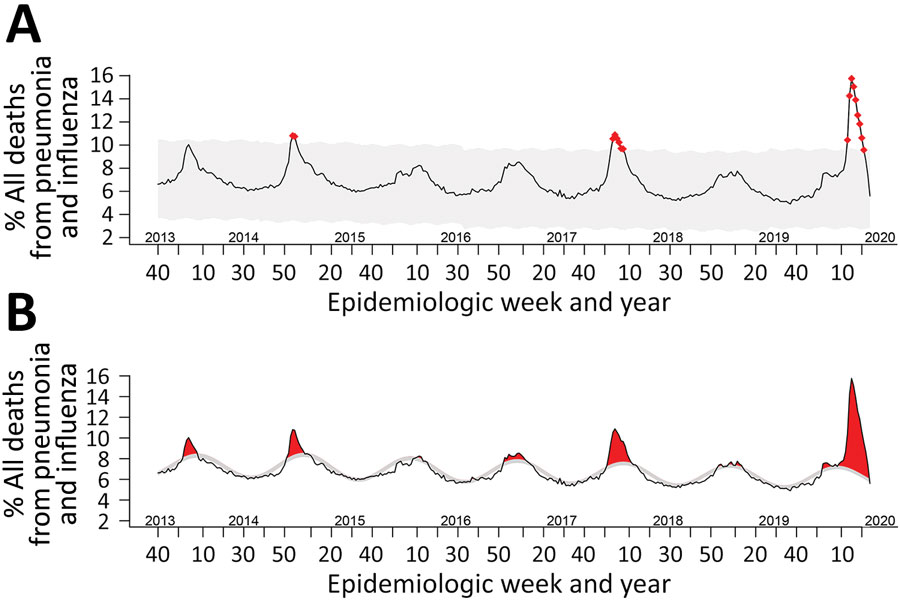Volume 26, Number 11—November 2020
Dispatch
Thresholds versus Anomaly Detection for Surveillance of Pneumonia and Influenza Mortality
Figure

Figure. Pneumonia and influenza mortality surveillance using anomaly detection analysis versus threshold method, United States. A) Line chart representing anomaly detection analysis of surveillance. Red points indicate anomalous data points. B) Line chart representing the pneumonia and influenza mortality data using the standard FluView (4) threshold method. Gray areas indicate values between expected (baseline seasonal mortality) and the epidemic threshold. Red areas indicate areas beyond expected or epidemic threshold values.
References
- World Health Organization. Top 10 causes of death 2016 [cited 2020 Aug 24]. https://www.who.int/en/news-room/fact-sheets/detail/the-top-10-causes-of-death
- Centers for Disease Control and Prevention. Influenza (flu): burden of influenza [cited 2020 Aug 24]. https://www.cdc.gov/flu/about/burden/index.html
- Bresee J, Fitzner J, Campbell H, Cohen C, Cozza V, Jara J, et al.; WHO Working Group on the Burden of Influenza Disease. WHO Working Group on the Burden of Influenza Disease. Progress and remaining gaps in estimating the global disease burden of influenza. Emerg Infect Dis. 2018;24:1173–7. DOIPubMedGoogle Scholar
- Centers for Disease Control and Prevention. Influenza (flu) weekly U.S. influenza surveillance report (FluView) [cited 2020 Aug 24]. https://www.cdc.gov/flu/weekly/index.htm
- Centers for Disease Control and Prevention. Influenza surveillance considerations [cited 2020 Aug 24]. https://www.cdc.gov/flu/weekly/overview.htm#anchor_1539281356004
- Schanzer DL, Langley JM, Dummer T, Aziz S. The geographic synchrony of seasonal influenza: a waves across Canada and the United States. PLoS One. 2011;6:
e21471 . DOIPubMedGoogle Scholar - Wiemken TL, Furmanek SP, Mattingly WA, Wright MO, Persaud AK, Guinn BE, et al. Methods for computational disease surveillance in infection prevention and control: Statistical process control versus Twitter’s anomaly and breakout detection algorithms. Am J Infect Control. 2018;46:124–32. DOIPubMedGoogle Scholar
- Vallis O, Hochenbaum J, Kejariwal A. A novel technique for long-term anomaly detection in the cloud [cited 2020 Aug 24]. https://www.usenix.org/system/files/conference/hotcloud14/hotcloud14-vallis.pdf
Page created: August 25, 2020
Page updated: October 19, 2020
Page reviewed: October 19, 2020
The conclusions, findings, and opinions expressed by authors contributing to this journal do not necessarily reflect the official position of the U.S. Department of Health and Human Services, the Public Health Service, the Centers for Disease Control and Prevention, or the authors' affiliated institutions. Use of trade names is for identification only and does not imply endorsement by any of the groups named above.